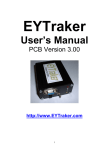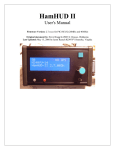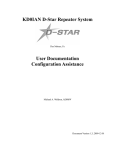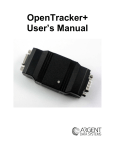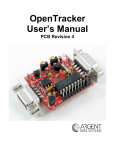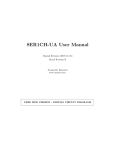Download javAPRSSrvr User's Guide
Transcript
DSTARInterface User's Guide 2.3b08 DSTARInterface is Copyright © 2009 - Pete Loveall AE5PL [email protected] Use of the software is acceptance of the agreement to not hold the author or anyone associated with the software liable for any damages that might occur from its use. APRS is a trademark of Bob Bruninga Other trademarks included in the following text are recognized as belonging to the respective trademark holders. i Table of Contents Section 1 - Introduction ......................................................................................................................... 1 Section 2 - Program Requirements and Description ............................................................................. 2 Section 3 - Configuration Parameters ................................................................................................... 3 javAPRSIGate Parameters ................................................................................................................ 4 TNCModule=.................................................................................................................................. 4 TNCIFieldMax=256 ........................................................................................................................ 4 TNC General Parameters .................................................................................................................. 4 TNCPortInit= .................................................................................................................................. 4 TNCPortInitWait=true ..................................................................................................................... 4 TNCSpeed=1200 ........................................................................................................................... 4 SerialInitFile= ................................................................................................................................. 4 Serial Port Parameters ...................................................................................................................... 5 PortClassName=RAFIntf ............................................................................................................... 5 SerialPortName= ........................................................................................................................... 5 Serial-to-TCP Port Parameters.......................................................................................................... 5 SerialToTCPPorts= ........................................................................................................................ 5 DSTAR D-STAR General Parameters ............................................................................................... 6 DSTARPortName= ........................................................................................................................ 6 DSTAREchoToRF=false ................................................................................................................ 6 DSTARDupeDelay=10 ................................................................................................................... 6 Section 4 - Recommended Configurations ........................................................................................... 7 Section 5 - Installation Instructions ....................................................................................................... 8 Section 6 - Status Page ........................................................................................................................ 9 Section 7 – Symbols ........................................................................................................................... 10 ii Section 1 - Introduction DSTARInterface was written to provide a universal interface between javAPRSIGate and a D-STAR enabled radio with a low-speed data port. The DSTARInterface source code is published for use by other developers to work with the javAPRSIGate TNCInterface 2.0. 1 Section 2 - Program Requirements and Description DSTARInterface is designed to run on any OS with any recent Java Virtual Machine. The interface requires the operating system and JVM to open the port in full duplex mode using a Java/serial-port interface. DSTARInterface is comprised of a number of classes which Java looks at as objects. The main class is DSTARInterface. This class is called at startup, sets parameters, and begins execution of the different support threads. DSTARInterface works in conjunction with the javAPRSIGate TNCInterface to provide full, bidirectional communication with the serial port. All IGate logic is handled at in javAPRSIGate which leaves the DSTARInterface to concentrate on formatting and sending packets to the TNC log ports. DSTARInterface gates to and from the radio using standard TNC2 format strings. This allows remote APRS clients to operate as if they were connected to a TNC. All APRS packets have a CRC sequence added to the beginning of the line to reduce packet corruption. The same algorithm/technique used in computing the D-STAR RF header FCS is used for the TNC2 lines. The CRC string is stripped from line before gating to APRS-IS. The line is of the format $$CRCxxxx,AE5PL>APRS:rest of packet DSTARInterface also converts the ICOM GPS-mode transmissions into an APRS posit. The first four letters of the GPS “message” are interpreted as a symbol per Appendix 2 of the APRS specification. A checksum (xor’ed from zero) prefixed by an asterisk is required in the GPS message. To simplify setting the GPS message, use the D-PRS Calculator at http://www.aprs-is.net/dprscalc.htm You must have JavaScript enabled in your browser to use that page. The first three letters of the message are used if they are separated from the rest of the text by a space (total of 4 characters) or there are only two or three letters in the message. The first three characters are interpreted as the xyz part of the APRS GPSxyz destination call system as outlined in the APRS specification. For instance, the GPS message (without quotes) “LK PETE IN TEXAS*17” would be interpreted as a truck symbol. Note that a space is in the z position as well as another space in the fourth character position. This allows the DSTAR radios to be used as standard trackers. Only the $GPRMC and $GPGGA strings are supported; other GPS strings are ignored. DSTAR callsigns are trimmed (leading and trailing spaces are eliminated) and imbedded space(s) are converted to a hyphen (the DSTAR radios do not support hyphens in the callsign). This allows a standard SSID configuration. The GPS message is also trimmed of all leading and trailing spaces. The $$CRCxxxx,packet format is compatible with the Icom GPS-A mode. This is the same format used by radios in that mode. Packets received from an Icom radio in GPS-A mode will be gated to APRS-IS once per transmission. Like GPS mode, GPS-A mode sends positions continuously while transmitting voice so only the first packet in a transmission is gated. 2 Section 3 - Configuration Parameters The configuration parameters reside in a configuration file which, by default, is called javaprssrvr.cfg. You can use any text file if you pass the name into javAPRSSrvr as a command line parameter. The parameters are CASE SENSITIVE. Defaults are shown below. NOTE: UNLESS YOU REQUIRE A SETTING OTHER THAN THE DEFAULT, DO NOT INCLUDE ANY PARAMETERS WITH DEFAULT SETTINGS. List parameters may be defined on the line or may be defined in a text file. If defined on the line, each entry is separated by a semicolon. If defined in a file, each entry is put on a separate line. Do not put blank lines in the file. The file must have the extension .lst For instance, this would be the definition for hubs where you want to connect to first.aprs.net and second.aprs.net port 1313: hubs=first.aprs.net:1313;second.aprs.net:1313 Or you could have the following 2 lines in hubs.lst: first.aprs.net:1313 second.aprs.net:1313 You would then put the following line in your configuration file: hubs=hubs.lst (R) at the beginning of the parameter description means that the parameter can be changed on-thefly from the console with either the S or R commands. 3 javAPRSIGate Parameters TNCModule= This must be set to DSTARInterface. Set to TNCModule=DSTARInterface TNCIFieldMax=256 (R)This sets the maximum information field length for packets gated to RF. Modify this only if there is an absolute requirement. Some TNC’s “break” if they send or receive packets with more than 256 octets in the information field. TNC General Parameters TNCPortInit= This defines a command line to be run before opening the TNC port. This may be a single command or a batch/script file. In Linux, be sure to prefix a script file with ./ so the file is executed. Also be sure to have execute rights for the desired script and programs. TNCPortInitWait=true This determines whether the interface should wait for the TNCPortInit command to complete before continuing. Set this to false if you are running a program which will remain operational after TNC initialization. TNCSpeed=1200 This sets pacing for the TNC interface. Set this to the RF speed of the TNC. This reduces the possibility of TNC overruns. This should be set to 900 for D-STAR radios. SerialInitFile= This defines file that is sent as-is to the TNC after the port is opened. This may be a file in the javAPRSSrvr directory or a fully qualified path to a file elsewhere on the computer. 4 Serial Port Parameters PortClassName=RAFIntf This is the name of the serial port class. Use this parameter to specify the name of the serial port class. It defaults to the Random Access File interface. SerialPortName= This is the name of the serial port. This supersedes DSTARPortName and is used by the serial port class. If not specified, it is set to DSTARPortName. Serial-to-TCP Port Parameters SerialToTCPPorts= (R)(List)This is the list of TCP/IP port(s) that will be listened to for a direct connection to the serial port. This is a bidirectional, unguarded (no security) port that allows a “direct” connection to the serial port. This is to be used with care as there is no flow control. 5 DSTAR D-STAR General Parameters DSTARPortName= (deprecated)This is the “file” name of the serial port. Most Linux/Unix derivatives use /dev/ttyS0 for the first serial port. Windows uses COM1 for the first serial port. DSTAREchoToRF=false (R)This sets whether to echo the DSTAR converted posit to RF. This parameter is only effective if IGateGateToRF=true. This parameter determines if posits created from remote DSTAR radios in GPS mode are to be echoed back to RF for remote APRS client use. DSTARDupeDelay=10 (R)This sets the “timeout” for resetting the posit flood prevention. The DSTAR radios continuously transmit their positions while the radio is transmitting digital voice. This parameter forces the IGate to pass a single posit at the beginning of the voice transmission and then wait for another station’s position or for the indicated time to lapse between voice transmissions from the same station. 6 Section 4 - Recommended Configurations The following is an example of using a Linux script to initialize the port and TNC if required. Note that these processes require root permission unless the permissions for the serial port are changed. The script file must also have execute permissions. javAPRSSrvr.cfg: <snip> TNCModule=DSTARInterface TNCSpeed=900 <snip> 7 Section 5 - Installation Instructions DSTARInterface is included in all of the combined jar and exe files. Simply add TNCModule=DSTARInterface to activate it. Icom radios running as trackers (GPS enabled) should have their callsign set to be callsign-space(s)SSID. The SSID is in the 8th character position (last character). The SSID may be any letter or number. Due to future repeater design, do not use A, B, C, D, G, S, zero, or space. See Section 2 regarding symbol interpretation for GPS-mode radios. DSTAR radios running as trackers should be configured to only pass RMC and GGA strings. The radios should be set to send to CQCQCQ for “broadcast” mode. 8 Section 6 - Status Page DSTAR Posits Converted 0 Number of DSTAR GPS positions converted to APRS 9 Section 7 – Symbols The following table shows the xyz values and their respective symbols. This table is derived from the table found at Bob Bruninga’s web site. If Z=#, an overlay of 0-9 or A-Z is allowed (overlays only allowed for secondary symbols). /$ /! /" /# /$ /% /& /' /( /) /* /+ /, //. // /0 /1 /2 /3 /4 /5 /6 /7 /8 /9 /: /; /< /= /> /? /@ /A /B /C /D /E /F /G /H /I /J /K /L /M /N /O /P /Q /R /S /T /U XYZ BB BC BD BE BF BG BH BI BJ BK BL BM BN BO BP P0 P1 P2 P3 P4 P5 P6 P7 P8 P9 MR MS MT MU MV MW MX PA PB PC PD PE PF PG PH PI PJ PK PL PM PN PO PP PQ PR PS PT PU PRIMARY SYMBOL TABLE Police, Sheriff reserved (had been rain) DIGI (white center) PHONE DX CLUSTER HF GATEway Small AIRCRAFT (SSID = 7) Mobile Satellite Station Wheelchair (handicapped) SnowMobile Red Cross Boy Scouts House QTH (VHF) X Dot # circle (obsolete) TBD (these were all) TBD (numbered circles) TBD (looking like billiard) TBD (balls until we came) TBD (up with Overlays) TBD (Now they are all) TBD (available for new) TBD (definitions...) TBD FIRE Campground (Portable ops!) Motorcycle (SSID = 10) RAILROAD ENGINE CAR (SSID = 9) SERVER for Files HC FUTURE predict (dot) Aid Station BBS or PBBS Canoe EYEBALL (Eye catcher!) Farm Vehicle (tractor) NEW Grid Square (6 digit) HOTEL (blue bed symbol) TcpIp on air network stn School Logged-on PCuser (Jan 03) MacAPRS NTS Station BALLOON (SSID = 11) Police TBD REC. VEHICLE (SSID = 13) SHUTTLE SSTV BUS (SSID = 2) \$ \! \" \# \$ \% \& \' \( \) \* \+ \, \\. \/ \0 \1 \2 \3 \4 \5 \6 \7 \8 \9 \: \; \< \= \> \? \@ \A \B \C \D \E \F \G \H \I \J \K \L \M \N \O \P \Q \R \S \T \U XYZ OB OC OD# OE OF OG# OH OI OJ OK OL OM ON OO OP A0# A1 A2 A3 A4 A5 A6 A7 A8 A9 NR NS NT NU NV# NW NX AA# AB AC AD AE AF AG AH AI AJ AK AL AM AN AO AP AQ AR AS AT AU SECONDARY SYMBOL TABLE (\) EMERGENCY (!) reserved NUMBERED STAR (green) Bank or ATM (green box) Overlayed GATEway Crash site CLOUDY Firenet MEO, MODIS Earth Obs...(NEW) SNOW Church Girl Scouts House (HF) Ambiguous Plot (Big Question mark) Waypoint Destination (D7/D700) Overlayed CIRCLE (E/I =IRLP/Echolink) Gas Station (blue pump) Hail Park/Picnic area ADVISORY NUMBERED CAR INFO Kiosk (Blue box with ?) HURICANE/Trop-Storm NUMBERED BOX Blowing Snow Coast Guard Drizzle Smoke Freezing rain Snow Shower Haze Rain Shower Lightening Kenwood HT (W) Lighthouse Navigation Buoy Rocket (new June 2004) Parking QUAKE Restaurant Satellite/Pacsat Thunderstorm SUNNY 10 /$ /V /W /X /Y /Z /[ /\ /] /^ /_ /` /a /b /c /d /e /f /g /h /i /j /k /l /m /n /o /p /q /r /s /t /u /v /w /x /y /z /{ /| /} /~ XYZ PV PW PX PY PZ HS HT HU HV HW HX LA LB LC LD LE LF LG LH LI LJ LK LL LM LN LO LP LQ LR LS LT LU LV LW LX LY LZ J1 J2 J3 J3 PRIMARY SYMBOL TABLE ATV National WX Service Site HELO (SSID = 6) YACHT (sail) (SSID = 5) WinAPRS Jogger TRIANGLE(DF station) MAIL/PostOffice (was PBBS) LARGE AIRCRAFT WEATHER Station (blue) Dish Antenna AMBULANCE (SSID = 1) BIKE (SSID = 4) Incident Command Post (NEW) Dual Garage (Fire dept) HORSE (equestrian) FIRE TRUCK (SSID = 3) Glider HOSPITAL IOTA (islands on the air) JEEP (SSID-12) TRUCK (SSID = 14) Logged-on laptop (Jan 03) Mic-E Repeater Node EOC ROVER (puppy, or dog) GRID SQ shown above 128 m ANTENNA like Radio station SHIP (pwr boat) (SSID-8) TRUCK STOP TRUCK (18 wheeler) VAN (SSID = 15) WATER station xAPRS (Unix) YAGI @ QTH reserved (Stream Switch) reserved (Stream Switch) \$ \V \W \X \Y \Z \[ \\ \] \^ \_ \` \a \b \c \d \e \f \g \h \i \j \k \l \m \n \o \p \q \r \s \t \u \v \w \x \y \z \{ \| \} \~ XYZ AV AW# AX AY AZ DS DT DU DV# DW# DX SA# SB SC# SD SE SF SG SH SI# SJ SK SL SM SN# SO SP SQ SR SS# ST SU# SV# SW SX SY SZ# Q1 Q2 Q3 Q4 SECONDARY SYMBOL TABLE (\) VORTAC Nav Aid NUMBERED NWS site (NWS options) Pharmacy Rx (Apothicary) Wall Cloud NUMBERED Aircraft NUMBERED WX site (green digi) Rain ARRL Overlays: ARES(A), WinLINK (W) Blowing Dust/Sand Civil Defense Overlays R=RACES C=CERTS DX spot by callsign Sleet Funnel Cloud Gale Flags HAM store Indoor BOXn digipeater (w overlay) WorkZone (Steam Shovel) SUV (new 29 June 2004) Area Locations (box,circles,etc) Value Signpost (3 digit display) NUMBERED TRIANGLE small circle Partly Cloudy Restrooms NUMBERED SHIP/boat (top view) Tornado NUMBERED TRUCK NUMBERED Van Flooding Skywarn Shelter (evacuation) (W Overlay) Fog 11















